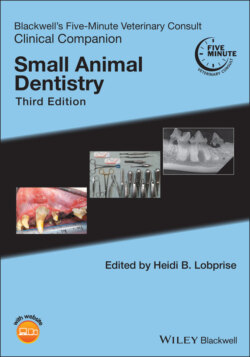Читать книгу Blackwell's Five-Minute Veterinary Consult Clinical Companion - Группа авторов - Страница 22
Challenging Radiographs
ОглавлениеDog: maxillary canine apex (Figure 3.20).Place sensor/film centered at the second premolar and palpate apex of canine tooth.Aim beam towards palpated apex, slight oblique off midline (see Figure 3.18).
Differentiation of mesial (towards the front of the tooth) and palatal roots of the upper fourth premolar (Figure 3.21).Shift the generator tube distally (towards the back of the tooth) to image the entire tooth without superimposition of the distal root over the first molar.Classically called SLOB (same lingual/opposite buccal) [4]. This means that the root that is more lingual (or palatal) will be imaged in the same direction. The root that moves in the opposite direction as the tube is the buccal root.If the distal root of the upper fourth premolar is imaged well (distal tube shift), the palatal root will move distally (the same direction as the tube) in comparison to the buccal root. The palatal root is in the middle of the distal and mesial roots (Figure 3.21).
Dog: maxillary molars.Place sensor/film lengthwise palatally, lined up with the two molars.Aim beam from above and slightly behind, almost directly aimed at film (Figure 3.22).
Dog: mandibular first premolars. It is challenging to place sensor far enough rostral in the intermandibular space for true parallel image.Intraoral: with sensor/film in place, aim beam from a position below (ventral) and rostral; this will “push” the image onto the film (Figure 3.23).
Dog: mandibular second and third molars.Pull the patient’s tongue out to allow the sensor/film to slide by the oral soft tissues.Position sensor/film further caudally, but also dorsally. Usually the caudal aspect of the sensor/film is angled and above the rostral half of the sensor/film (keep in place with perm roller).Figure 3.20 Maxillary canine apex in dog: aim beam towards palpated apex, slight oblique off midline.Figure 3.21 (a) Standard beam positioning for the upper fourth premolar and its radiograph. (b) Beam position with distal tube shift and SLOB technique radiograph showing the palatal root in the middle.Figure 3.22 Maxillary molars in dog: place sensor/film lengthwise palatally, lined up with the two molars. Aim beam from above and slightly behind, almost directly at film.Figure 3.23 Mandibular first premolars in dog: with sensor/film in place intraorally, aim beam from a position below (ventral) and rostral. This will “cast the shadow” or “push” the image onto the film.Figure 3.24 Mandibular second and third molars in dog: position sensor/film further caudally, but also dorsally; don’t let it slide ventrally (keep in place with perm roller). Aim beam from a position caudal and dorsal to the film, using the tape roll to assist; this will “cast the shadow” or “push” the teeth onto the image.Aim beam from a position caudal and dorsal to the film. This will “push” the teeth onto the image, using the tape roll to assist (cast the shadow onto the film) (Figure 3.24).
Maxillary premolars of cats and brachycephalic dogs.Keep mouth open with perm roller or 30‐mm clear mouth gag [9], place sensor/film under the maxillary premolars on the downside, slightly dorsal to the teeth (Figure 3.25).Aim beam from above and caudally, at a slight oblique, so the image of the “downside” maxillary premolars will be projected on the film underneath (follow the beam), and the “upside” maxillary teeth will not be superimposed (Figure 3.26). Mark the image as extraoral for later identification purposes.Note: since the beam is further from the film than in an intraoral method, additional exposure time may be necessary.
Figure 3.25 Maxillary premolars of cats and brachycephalic dogs: keep mouth open with perm roller or 30‐mm clear mouth gag. Place sensor/film under the maxillary premolars on the “downside,” more dorsal to the teeth.
Figure 3.26 Aim beam from above and caudally, at a slight oblique, so the image of the “downside” maxillary premolars will be projected on the film underneath (follow the beam), and the “upside” maxillary teeth will not be superimposed. Note or mark the film as extraoral for later identification purposes.
